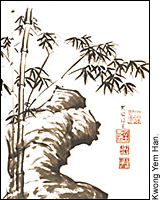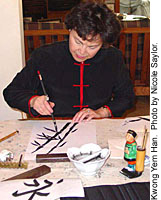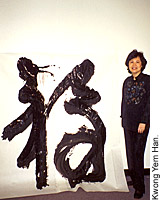Home | Search | The Artists | Teaching | Hiring | About This Site | Contact Us

Chinese painting and calligraphy
Pepin, WI
 Yem
Han is a calligrapher
and a painter, like many Chinese artists before her. The
connection between these two beautiful art forms is very strong in Chinese
culture.
Yem
Han is a calligrapher
and a painter, like many Chinese artists before her. The
connection between these two beautiful art forms is very strong in Chinese
culture.
The eight basic strokes in writing are the same strokes used in painting. A flick of the brush to make a Chinese character might be the same stroke needed to create bamboo leaves.
Peaceful Painting
In Chinese painting, less is more. “The philosophy is that simplicity is what counts. It’s like seeing simple things in life, like a single red rose,” Yem Han explained. “It’s just very simple.”
Traditional Chinese paintings often depict landscapes. You’ll see a mountain scene, lakes, waterfalls, trees, birds, or rocks. Often the object starts out in the distance then the object in view comes closer. Look at a Chinese painting. You’ll see a hazy mountain scene. Then it slowly focuses in the middle. As you look at the parts that are nearer, they get clearer and clearer. The images are hazy in the background, clearer in the middle, and clearest up close. Try to see these principles in Yem Han’s work in the slide show.
|
|
|
All of the images are meant to
portray serenity and calm. “The peaceful state of mind is you’re there by yourself looking at
nature, you’re looking at the sky, you’re looking at the mountains, you’re looking at the birds
flying, and you’re at peace with yourself, and that’s
![]() what Chinese traditional painting is all
about. You find peace within yourself when you look at a painting,” Yem Han
explained.
what Chinese traditional painting is all
about. You find peace within yourself when you look at a painting,” Yem Han
explained.
 Yem Han said that the soft, pastel colors and serene scenes found in Chinese painting are well suited to her personality. “I’m a very
calm person, a very patient person,” she said. “I like things that are simple, and I think that’s the Chinese tradition.
It’s not the materialistic things; it’s the simple things in life that count and so you don’t need much to be happy. Also, living in
Pepin, it’s a very simple life. You can look at a flower and really appreciate
it.”
Yem Han said that the soft, pastel colors and serene scenes found in Chinese painting are well suited to her personality. “I’m a very
calm person, a very patient person,” she said. “I like things that are simple, and I think that’s the Chinese tradition.
It’s not the materialistic things; it’s the simple things in life that count and so you don’t need much to be happy. Also, living in
Pepin, it’s a very simple life. You can look at a flower and really appreciate
it.”
|
Yem Han writing “Eternity”:
|
How to Learn
You learn a lot by watching the master teacher. This is part of the traditional way of learning Chinese painting. Yem Han explains, “You learn the basics by watching and copying and then you go on your own. The Chinese way is copy the painting, then you study the flick of the brush, the landscape. Once you master that you must take off on your own.”
![]() Listen to Yem Han
explain more about learning Chinese calligraphy and painting. You can read
along here.
Listen to Yem Han
explain more about learning Chinese calligraphy and painting. You can read
along here.
Local Traditions Too
Since going out on her own, Yem Han has not only become a skilled Chinese painter but also has dabbled in a similar art form popular in Wisconsin — Norwegian rosemaling. Both types of painting use soft colors, specific brush strokes, and use two colors on the paintbrush.
“Rosemaling and Chinese painting go hand in hand,” Yem Han said. “If you
can do rosemaling you can do Chinese painting. Yes, I’ve done
rosemaling. I think
 it’s fun. The technique is basically the same. If you look at the flowers
in the rosemaling they are the same as those in Chinese
painting.”
it’s fun. The technique is basically the same. If you look at the flowers
in the rosemaling they are the same as those in Chinese
painting.”
If you look closely at Yem Han’s shirt in the photo, you’ll notice it has rosemaling on it. Click on it to see details and compare it with an example of rosemaling by Lois Mueller.
Being a role model
If you want to learn more about Chinese traditional painting and calligraphy, invite Yem Han to your school. She is eager to teach Wisconsin students about her art and heritage. There aren’t many Asians in Wisconsin, she says, not like there are in California. So in Wisconsin, students don’t learn much about Asian art. “I think it’s so important,” she believes.
Yem Han remembered a time when she met a girl who had never been exposed to
Chinese art before. “I was a guest speaker for the Walker Museum, and
![]() one
Asian girl came up to me afterward and said, ‘Wow! This is fantastic! You’re my
role model!’”
one
Asian girl came up to me afterward and said, ‘Wow! This is fantastic! You’re my
role model!’”
“I think that children need a good role model. I hope I would be a good one to share my paintings and the story of what I have done in my life.”
Kwong Yem Han is a role model for bringing the beautiful art and tradition of Chinese painting and calligraphy to Wisconsin.
Learn More!
To find out if there is a traditional Chinese painter or calligrapher in your community, check your local community or technical college. They might be offering a class. For lots more on Chinese calligraphy, go to Resources for Students. You’ll find fun games and learning activities in the links.

For Educators:
“It’s a great honor that my master teacher believed in me and gave me all the instruction and the techniques to do this. I am very thankful.”
– Kwong Yem Han
Home | Search | The Artists | Teaching | Hiring | About This Site | Contact Us

